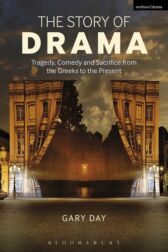Synopsis
The Story of Drama
Published by Methuen
It offers readers an exceptional study of the development of both genres, grounded in analysis of landmark plays and their context, arguing that sacrifice is central to both genres, and demonstrates how it provides a key to understanding the grand sweep of Western drama
For students of literature and drama the volume serves as an accessible companion to over two millennia of drama organised by period, and reveals how sacrifice represents a through-line running from classical drama to today's reality TV and blockbuster movies
Across the chapters devoted to each period, Gary Day explores how the meanings of sacrifice change over time, but never quite disappear
He charts the influences of religion, social change and politics on the status and purposes of theatre in each period, and on the drama itself
But it is through a close study of key plays that he reveals the continuities centred around sacrifice that persist and which illuminate aspects of human psychology and social organisation
Among the many plays and events considered are Aeschylus' trilogy The Oresteia, Aristophanes' Women at the Thesmorphia, Menander's The Bad-Tempered Man, the spectacles of the Roman Games, Seneca's The Trojan Women, Plautus's The Rope, the Cycle plays and Everyman from the Middle Ages, Shakespeare's King Lear and A Midsummer Night's Dream, Middleton's The Revenger's Tragedy, Jonson's Every Man in His Humour, Thomas Otway's The Orphan, William Wycherley's The Country Wife, Wilde's A Woman of No Importance, Beckett' Waiting for Godot, Tennessee Williams's A Streetcar Named Desire, Suzan-Lori Parks's Topdog/Underdog, Sarah Kane's Blasted and Charlotte Jones' Humble Boy
A conclusion examines the persistence of ideas of sacrifice in today's reality TV and blockbuster movies
TABLE OF CONTENTS
Acknowledgements
Chapter 1: Sacrifice
Chapter 2: Tragedy, Comedy and Ritual
Chapter 3: Greek Tragedy and Comedy and Sacrifice
Chapter 4: Roman Tragedy and Comedy and Sacrifice
Chapter 5: Medieval Tragedy and Comedy
Chapter 6: Renaissance Tragedy and Comedy and Sacrifice
Chapter 7: Restoration and Eighteenth Century Tragedy and Comedy and Sacrifice
Chapter 8: Victorian Melodrama, Comedy, Naturalism and Sacrifice
Chapter 9: Tragedy, Comedy and Sacrifice in the Twentieth and Twenty First Centuries
Conclusion: Tragedy, Comedy and Sacrifice in Popular Culture
Notes
Index
 $31.99
$31.99